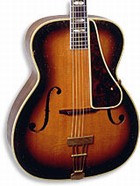
While the Martin Guitar Company is today best known for its flat-top steel-string guitars, from 1931 through 1942 the company produced a significant number of archtop guitars designed to appeal to players of the orchestral style of music popular at the time. Some of the ornamental features now associated with Martin flat-tops were in fact originally designed for its archtop instruments.
The vertical CF Martin-inlayed peghead logo first appeared in 1931 on the style C-2 archtop roundhole guitar. The first such logos were inlayed “Martin,” with the “CF” added slightly later. The hexagon fingerboard inlays first appeared on the model F-9 and F-7 archtops, both of which featured vertical stripes on the fingerboard in addition to the hexagons. While the necks on these guitars clearly are quite similar to that associated with the model D-45, it should be noted the D-45 did not feature hexagon inlays until 1939. In addition, the F-9 features a tortoiseshell-grained peghead veneer and gold-plated Grover tuners with ornamental “CFM” engraving on the buttons. Tuners of this style were used on the C-3, F-9, and on some D-45s.
The F-9 guitar was introduced in 1935. At a list price of $250, it was the most expensive item in the Martin catalog. D-45s listed at only $200 until late 1941, at which time they were raised to $250, and the F-9 was raised to $275.
The F-9 is one of Martin’s rarest models. From its introduction in ’35 until it was discontinued in ’42, a total of 72 were produced. By contrast, from ’33 through ’42, when the model was discontinued, 91 D-45s were manufactured. The F-9 features extremely fine craftsmanship, but the design on this and other Martin carved-top guitars is quite different from that of “traditional” carved-top by Gibson, Epiphone, D’Angelico, and Stromberg.
Whereas a standard archtop guitar features a carved back, carved top, and fingerboard raised off the top, Martin archtops feature what is essentially the same structure as a typical Martin flat-top, with the addition of a carved top and adjustable archtop-style bridge and tailpiece. As a consequence of the height of the top and the bridge, the neckset angle is so acute that when the instruments are laid on a flat surface they rest on the tip of peghead and the end of the body.
In addition, conventional archtop guitars typically feature maple back and sides, whereas Martin utilized the same woods as on its flat-top guitars. The budget-priced models featured mahogany neck. The R-size Martins were similar in size to the 00 size flat-top guitars, whereas the C series was 15″ wide (as on an OM or 000 flat-top) and the F series was 16″ wide. Interestingly enough, prior to Word War II this 16″ body width (with shape similar to the 000 series) was not used on any flat-top guitars. It was not until much later that this size and shape was finally used on the style M guitars now designated as 0000 size. The same shape with D depth is also used today on the Jumbo J-sized Martin. Martin introduced the Ms after many years of requests from players and after observing many people were having F-sized archtops converted to flat-tops.
While Martin’s carved-top guitars feature fine workmanship and sound quite good, they are distinctly different in sound from the traditional-design orchestral rhythm guitars. As a result, they did not achieve widespread popularity among professional players and production ceased with the start of WWII. It should be noted however, that during production, sales of Martin archtops were strong enough to contribute a significant portion of Martin’s sales. During the Depression, the company needed every sale it could get. Archtop guitars were, without a doubt, important in contributing to the company’s survival during this period.
The F-9 is an historically significant instrument worthy of attention from the most discriminating collector. It is beautifully crafted, fine-sounding, and a very rare instrument.
Martin F-9 guitar from 1939, serial number 72188. Photo: Robert Parks , courtesy of George Gruhn.
This article originally appeared in VG‘s Sep. ’98 issue. All copyrights are by the author and Vintage Guitar magazine. Unauthorized replication or use is strictly prohibited.


